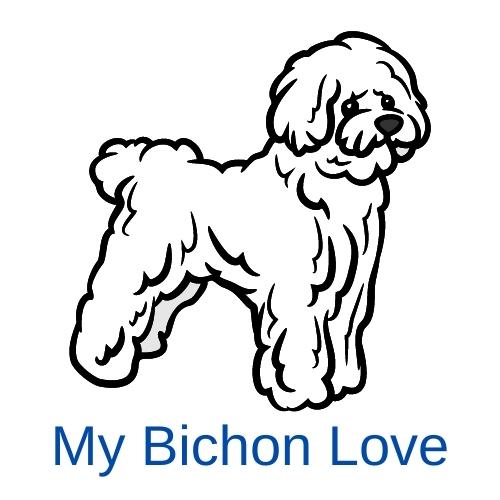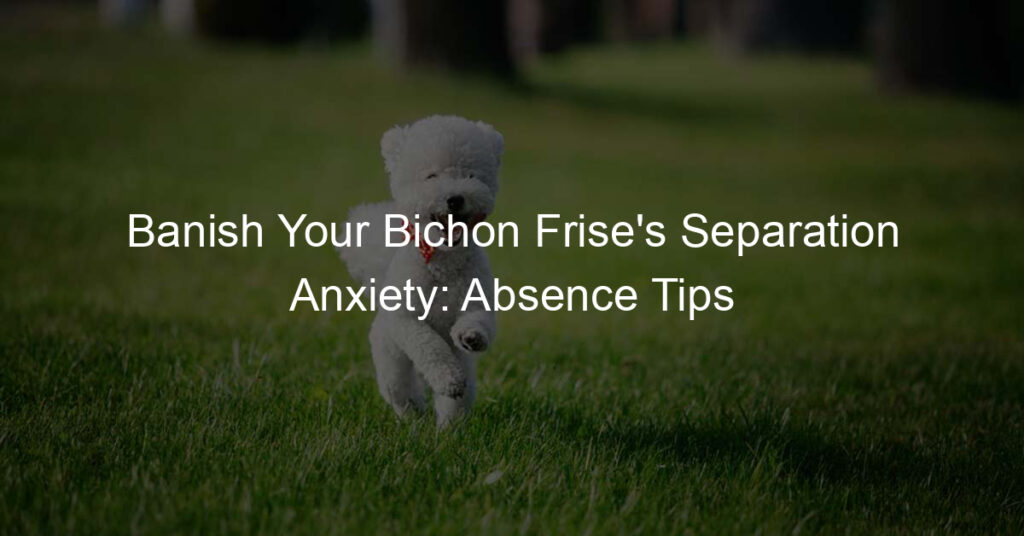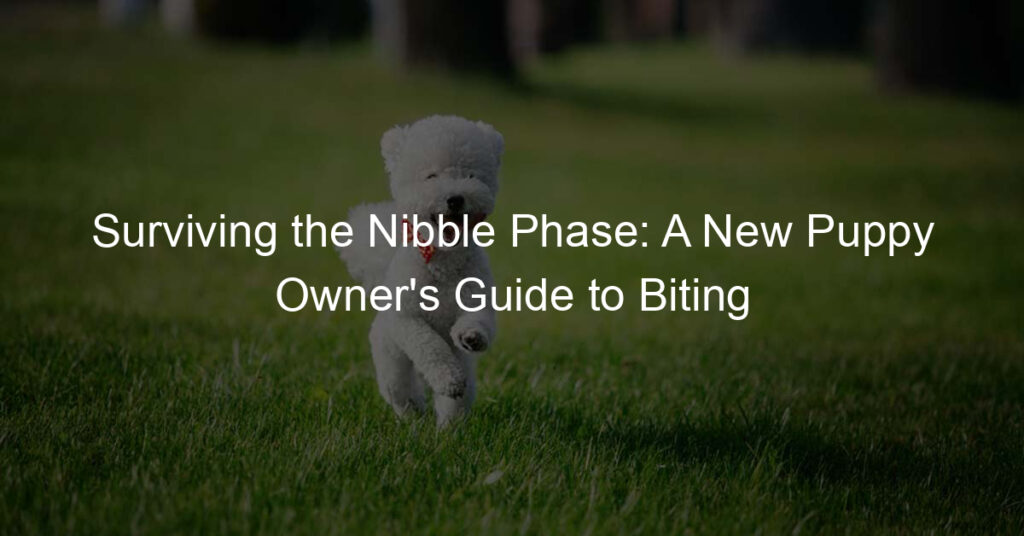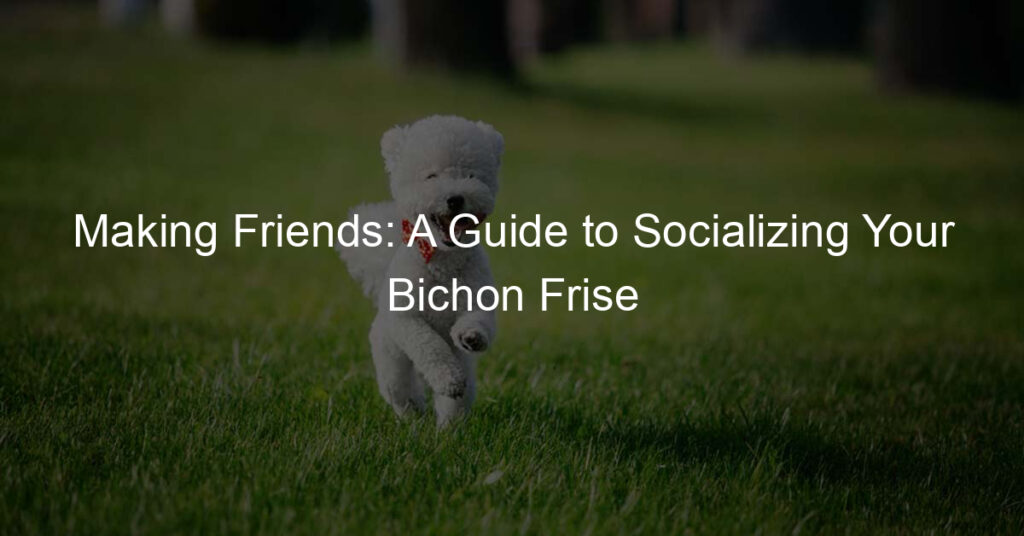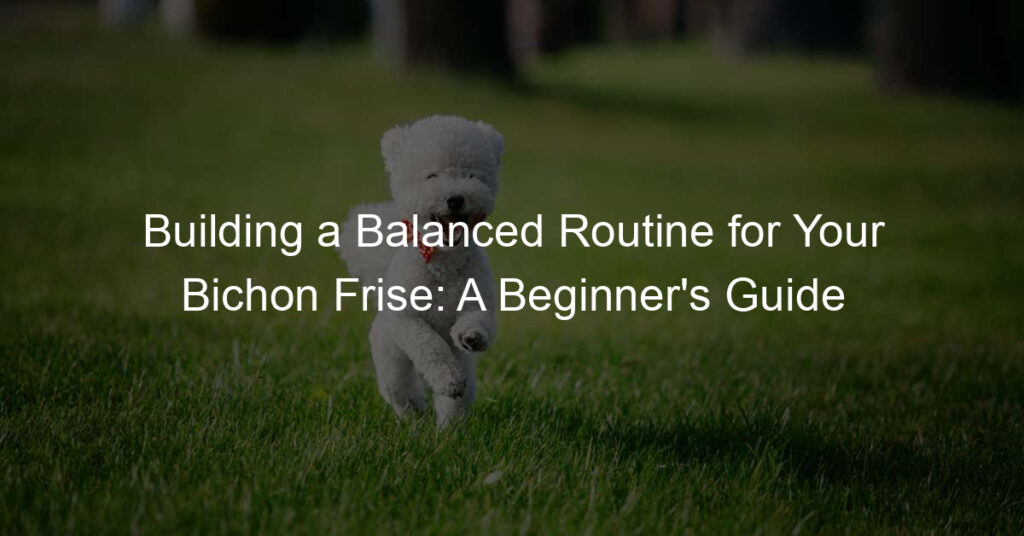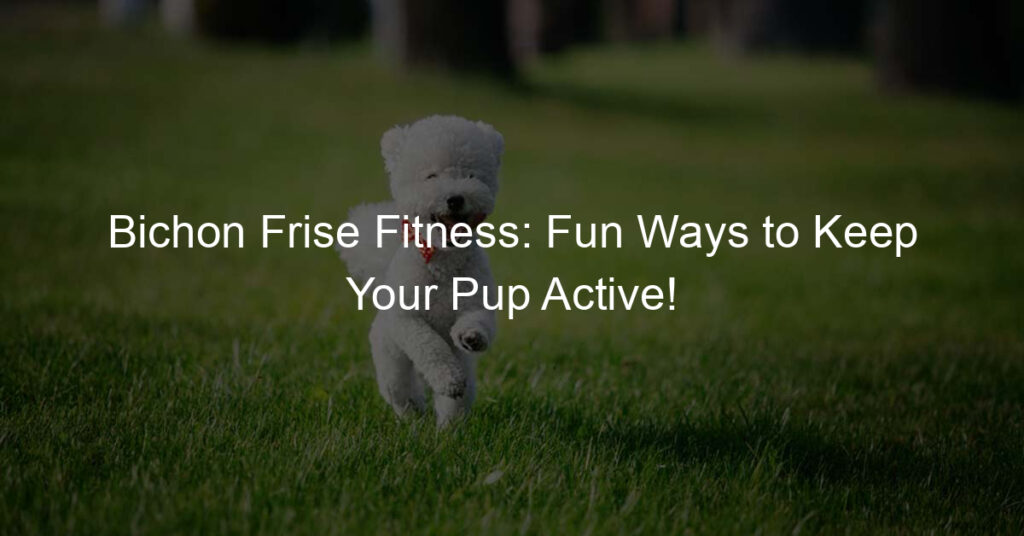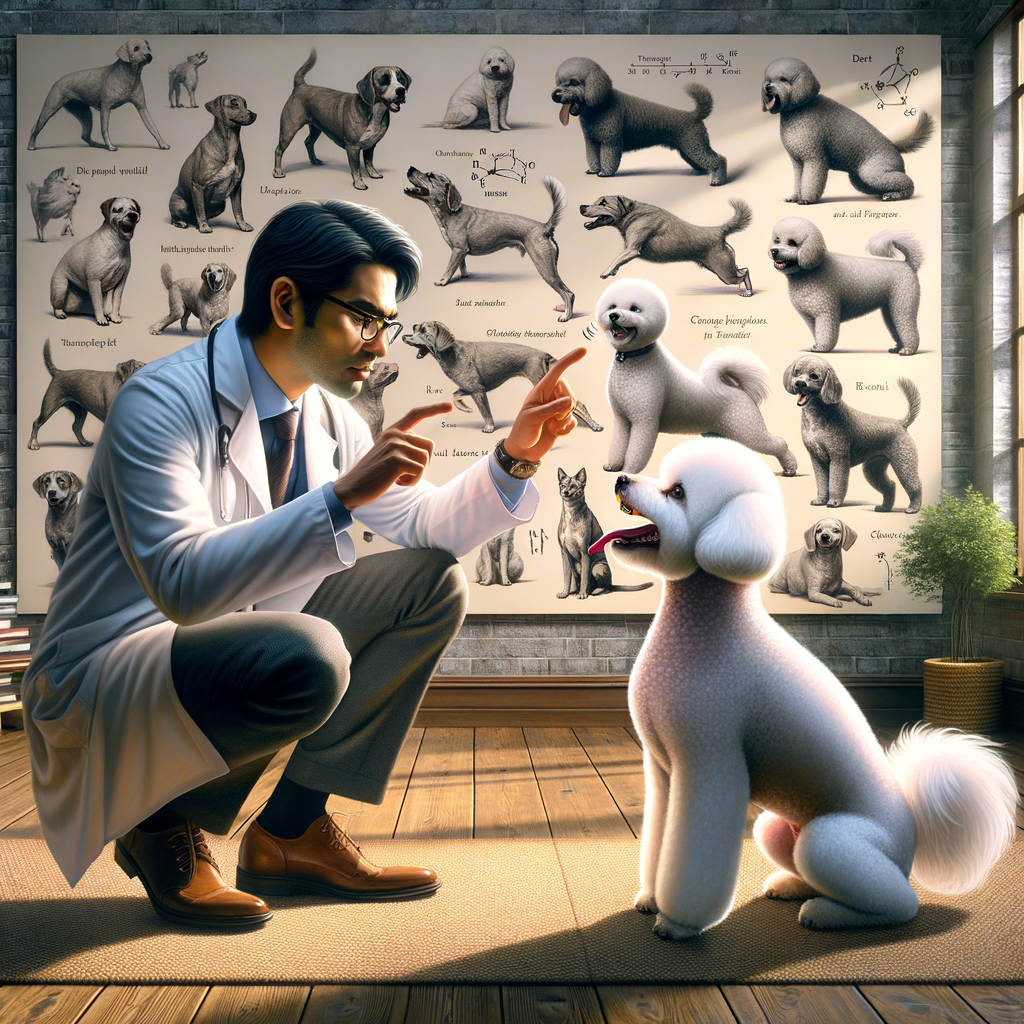
Introduction to Bichon Frise Body Language
Communication is a fundamental aspect of any relationship, including the one between you and your Bichon Frise. Understanding your pet’s body language can significantly enhance your bond and ensure their well-being. In this section, we will delve into the fascinating world of canine communication, focusing on the unique signals of the Bichon Frise breed.
- Understanding canine communication
- The importance of interpreting Bichon Frise signals
Canine communication is a complex system of signals that dogs use to express their feelings, intentions, and needs. Dogs communicate primarily through body language, using various parts of their bodies, including their ears, tail, eyes, and posture. For instance, a wagging tail often signifies happiness, while flattened ears may indicate fear or submission.
However, it’s important to remember that not all dogs communicate in the same way. The Bichon Frise, for example, is known for its lively and expressive body language. They are often seen wagging their tail rapidly when excited or raising their paw when they want attention. Understanding these unique signals can help you better understand your Bichon Frise’s needs and emotions.
Interpreting your Bichon Frise’s signals is crucial for several reasons. Firstly, it allows you to respond appropriately to their needs, ensuring their happiness and well-being. For example, if your Bichon Frise is showing signs of stress or discomfort, you can take steps to alleviate their distress.
Secondly, understanding your Bichon Frise’s body language can help prevent potential issues. For instance, if your dog is showing signs of aggression, understanding these signals can help you intervene before the situation escalates.
Lastly, interpreting your Bichon Frise’s signals can strengthen your bond with them. By responding appropriately to their signals, you show your pet that you understand and care for them, fostering a deeper connection.
In the following sections, we will delve deeper into the specific behaviors and signals of the Bichon Frise breed, providing you with the knowledge you need to understand your furry friend better.
Understanding Bichon Frise Behavior
Understanding the behavior of your Bichon Frise is key to building a strong bond with your pet. This breed has unique behavioral patterns that can be categorized into three main types: playful, aggressive, and submissive. Let’s delve deeper into these behaviors to better understand our furry friends.
Common Bichon Frise Behavior Patterns
- Playful behavior
- Aggressive behavior
- Submissive behavior
Bichon Frises are known for their playful and energetic nature. They love to run around, play fetch, and engage in interactive games. Their playful behavior is often characterized by a wagging tail, excited barking, and a spring in their step. This behavior is not only a sign of their happiness but also their way of burning off energy and staying fit.
Aggressive behavior in Bichon Frises is not common, but it can occur under certain circumstances. This behavior may manifest as growling, baring teeth, or even snapping. It’s important to note that aggression is often a response to fear, stress, or territorial instincts. Early socialization and proper training can help minimize aggressive behavior in Bichon Frises.
Submissive behavior is often seen when a Bichon Frise feels threatened or is trying to show respect to a dominant figure. This can include behaviors like rolling over to expose their belly, avoiding eye contact, or lowering their body to the ground. It’s crucial to understand that this behavior is not a sign of weakness, but a form of communication in the dog world.
Understanding these common behavior patterns can help you better communicate with your Bichon Frise and respond appropriately to their needs. Remember, every dog is unique and may not strictly adhere to these behaviors. Observing and learning from your pet’s behavior is the best way to understand them.
Interpreting Bichon Frise Communication Signals
Understanding your Bichon Frise’s communication signals is key to building a strong and healthy relationship with your furry friend. Let’s delve into the world of Bichon Frise communication and learn how to interpret their tail wagging, ear movements, and vocalizations.
- Understanding Bichon Frise Tail Wagging
- Decoding Bichon Frise Ear Movements
- Interpreting Bichon Frise Vocalizations
Tail wagging is a common form of communication among dogs. For Bichon Frise, a high and fast wagging tail usually indicates excitement or happiness. On the other hand, a low and slow wagging tail may suggest that your Bichon Frise is feeling nervous or unsure. Remember, context is key when interpreting tail wagging. For instance, if your Bichon Frise is wagging its tail while playing, it’s likely a sign of joy.
Ear movements can also provide valuable insights into your Bichon Frise’s emotions. When your Bichon Frise’s ears are erect and forward, it usually means they are alert and interested in something. If their ears are flattened against their head, it can indicate fear or submission. Again, consider the overall context and other body language signals when interpreting ear movements.
Vocalizations are another important aspect of Bichon Frise communication. Bichon Frises have a range of vocalizations, including barks, growls, whines, and howls. A high-pitched, rapid bark often indicates excitement, while a low-pitched, slow bark may suggest a warning or threat. Whining can indicate discomfort or desire for attention. Remember, each Bichon Frise is unique, so it’s important to spend time with your pet to understand their specific vocalizations.
Understanding your Bichon Frise’s communication signals can greatly enhance your bond and ensure your pet’s well-being. Always pay attention to their body language and vocalizations, and respond with love and care.
Canine Body Language: A Detailed Look
Understanding a dog’s body language is crucial for effective communication with our furry friends. Let’s delve into the fascinating world of canine body language and explore the different types of dog postures.
Understanding Dog Posture
Just like humans, dogs communicate a lot through their body language. Their posture can tell us if they are relaxed, aggressive, or fearful. Here’s a closer look at these three common postures:
- Relaxed Posture
- Aggressive Posture
- Fearful Posture
A dog in a relaxed posture is comfortable and content. They stand with their head and tail in a neutral position, not too high or too low. Their mouth may be slightly open, and their tongue may be lolling out. This posture indicates that the dog is calm and not feeling threatened.
An aggressive dog will try to make itself look bigger. They stand tall, with their tail raised high and stiff. Their ears are also pricked up, and they may show their teeth. This posture is a clear warning sign that the dog is ready to defend itself and may attack if provoked.
A fearful dog will try to make itself look smaller. They crouch low to the ground, with their tail tucked between their legs. Their ears are flat against their head, and they may whimper or whine. This posture indicates that the dog is scared and trying to avoid any confrontation.
Recognizing these postures can help us better understand our dogs’ emotions and respond appropriately. Remember, a dog’s body language is a window into their mind. By paying close attention to their posture, we can build a stronger bond with our canine companions.
Understanding Dog Facial Expressions
One of the most fascinating aspects of dog behavior is their facial expressions. Just like humans, dogs use their faces to communicate their emotions. Let’s delve into the different types of expressions that dogs typically exhibit.
- Happy expressions:
- Angry expressions:
- Scared expressions:
When a dog is happy, their eyes are bright and their mouth is slightly open, often resembling a relaxed smile. Their ears are usually in a neutral or relaxed position. They may also wag their tail in a relaxed manner. This expression is often seen when they are playing or interacting with their favorite human.
An angry dog may have narrowed eyes and a wrinkled brow. Their ears are usually pinned back, and they may show their teeth in a snarl. This expression is a clear warning sign that the dog is upset and may become aggressive if provoked.
A scared dog often has wide, staring eyes and their ears are flat against their head. They may tuck their tail between their legs and their body may be lowered. This expression indicates that the dog is feeling threatened and may react defensively.
Understanding these facial expressions can greatly improve your relationship with your dog. It allows you to respond appropriately to their emotional state, which can help to build trust and mutual respect.
| Expression | Signs |
|---|---|
| Happy | Bright eyes, relaxed mouth, neutral or relaxed ears, wagging tail |
| Angry | Narrowed eyes, wrinkled brow, pinned back ears, snarling teeth |
| Scared | Wide eyes, flat ears, tucked tail, lowered body |
Remember, every dog is unique and may display these expressions slightly differently. Always consider the overall body language and context when interpreting a dog’s facial expression.
Case Studies: Dog Behavior in Action
Let’s delve into real-life scenarios to better understand Bichon Frise behavior. Our first case study focuses on a Bichon Frise adapting to a new environment.
Case Study 1: Bichon Frise in a New Environment
In this case study, we observed a Bichon Frise named Bella, who recently moved to a new home with her family. Bella’s behavior was closely monitored for a month to understand how she adapted to her new surroundings.
- Observations
- Interpretations
During the first week, Bella displayed signs of anxiety and confusion. She often paced around the house, whined, and had a decreased appetite. However, by the second week, Bella started to explore her new home more confidently. She began to eat regularly and showed signs of happiness like wagging her tail and playing with her toys. By the end of the month, Bella seemed to have completely adjusted to her new environment.
The initial signs of anxiety and confusion Bella displayed are common in dogs adjusting to a new environment. These behaviors indicate stress and uncertainty. However, as Bella became more familiar with her new surroundings, her anxiety levels decreased, and she began to exhibit normal dog behaviors. This case study shows that with patience and consistency, dogs can successfully adapt to new environments.
In conclusion, understanding a Bichon Frise’s behavior in a new environment can help pet owners provide the necessary support and patience during the adjustment period. Remember, each dog is unique and may require different amounts of time to adapt.
Case Study 2: Bichon Frise Interacting with Other Dogs
In this section, we will explore a case study that focuses on the interaction of a Bichon Frise with other dogs. This case study will provide valuable insights into the behavior and body language of Bichon Frises when they are in the company of their canine peers.
- Observations
- Interpretations
Our observation session involved a Bichon Frise named Bella. Bella was introduced to a dog park where different breeds of dogs were present. Initially, Bella exhibited signs of curiosity and excitement. Her tail was wagging, and her ears were perked up, indicating interest.
As Bella began interacting with other dogs, we noticed a change in her body language. When a larger dog approached her, Bella’s tail went between her legs, and she lowered her body closer to the ground. This is a common sign of submissiveness or fear in dogs. However, when Bella interacted with dogs of her size or smaller, she was more relaxed and playful.
The observations suggest that Bella, like many Bichon Frises, is comfortable around dogs of her size or smaller. The submissive posture she exhibited when a larger dog approached could be a sign of fear or respect. It’s important to note that each dog is unique, and their reactions can vary based on their personality and past experiences.
Understanding these subtle changes in a Bichon Frise’s body language can help owners better understand their pet’s comfort levels and social preferences. This knowledge can guide decisions about playdates and interactions with other dogs.
In conclusion, observing and interpreting the body language of a Bichon Frise when interacting with other dogs can provide valuable insights into their behavior and preferences. Remember, a happy and comfortable dog is a healthy dog!
Conclusion: The Importance of Understanding Dog Body Language
As we reach the end of our journey exploring the fascinating world of Bichon Frise body language, it’s crucial to understand the importance of this knowledge. Being able to interpret your dog’s signals can greatly enhance your relationship with your furry friend and ensure their well-being.
- Benefits of Interpreting Bichon Frise Signals
Understanding your Bichon Frise’s body language has numerous benefits. It allows you to respond appropriately to their needs, ensuring they feel loved and cared for. It can also help prevent potential issues, as dogs often use body language to communicate discomfort or distress.
For instance, if your Bichon Frise starts to show signs of aggression, understanding their body language can help you identify the cause and take steps to resolve it. This can lead to a happier, healthier dog and a more harmonious home environment.
- Key Takeaways
Throughout this article, we’ve covered a lot of ground. Here are the key points to remember:
- Bichon Frise dogs have a unique set of body language signals that they use to communicate with their owners.
- Understanding these signals can help you respond appropriately to your dog’s needs, leading to a happier and healthier pet.
- Regular observation and interaction with your Bichon Frise will help you become more adept at interpreting their body language.
Remember, every dog is unique, and it may take time and patience to fully understand your Bichon Frise’s body language. But the rewards of this understanding are well worth the effort.
In conclusion, understanding your Bichon Frise’s body language is an essential part of responsible pet ownership. It can significantly enhance your relationship with your pet and ensure their well-being. So, keep observing, keep learning, and enjoy the wonderful journey of pet ownership.
